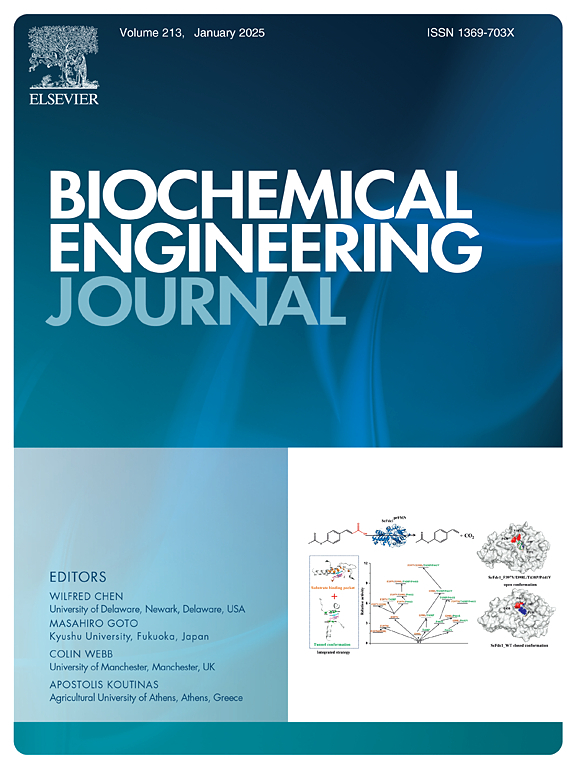采用响应面方法对废水进行天然杀菌剂辅助超声波消毒
IF 3.7
3区 生物学
Q2 BIOTECHNOLOGY & APPLIED MICROBIOLOGY
引用次数: 0
摘要
废水中的耐多药(MDR)细菌日益增多,对公共卫生和环境构成了严重威胁,因此需要采用更有效、更可持续的消毒方法。臭氧消毒和氯化消毒往往无法消除这些细菌,而且会产生有毒的副产品。本研究介绍了一种新颖的消毒策略,它将超声波与茶树油相结合,针对住宅污水处理系统中的 MDR 细菌,旨在提供一种环保、高效和可扩展的解决方案。该方法利用茶树油的天然杀菌特性和超声波的物理效应,尤其是声空化效应,来提高细菌灭活效果。温度、杀菌剂用量和超声功率是利用响应面方法进行优化的三个主要因素。该系统可在 30 分钟内使二级污水中的细菌总数减少 2.2-2.4 log CFU/mL,并在 50 分钟内完全消毒接种了高强度 MDR 细菌(6-log CFU/mL)的改良污水。最佳条件为 698.4 瓦功率、1.234 微升/毫升茶树油和 20.64 °C。核酸释放和呼吸链脱氢酶抑制表明细菌细胞膜破裂。重新生长测试表明,该方法长期有效,三天后就没有细菌菌落了。混合技术使用天然杀菌剂,降低了操作成本,缩短了操作时间,因此具有商业和环境效益。该技术能够去除 MDR 细菌,因此成为大规模废水处理的有力竞争者。本文章由计算机程序翻译,如有差异,请以英文原文为准。
Natural biocide-assisted ultrasonic disinfection of wastewater effluent following a response surface methodology approach
The increasing prevalence of multidrug-resistant (MDR) bacteria in wastewater poses a significant threat to public health and the environment, necessitating more effective and sustainable disinfection methods. Ozonation and chlorination frequently fall short of eliminating these bacteria and can create toxic byproducts. This study introduces a novel disinfection strategy that combines ultrasonication with tea tree oil to target MDR bacteria in residential wastewater treatment systems, aiming to provide an eco-friendly, efficient, and scalable solution. The method harnesses tea tree oil's natural biocidal properties alongside the physical effects of ultrasonication, particularly acoustic cavitation, to enhance bacterial inactivation. Temperature, biocide dosage, and ultrasonication power were the three main factors that were optimized using response surface methodology. The system achieved a 2.2–2.4 log CFU/mL reduction of total bacteria in secondary effluent within 30 min and complete disinfection of modified effluent inoculated with high-strength MDR bacteria (6-log CFU/mL) in 50 min. Optimal conditions were 698.4 Watt power, 1.234 µl/mL tea tree oil, and 20.64 °C. Nucleic acid release and respiratory chain dehydrogenase inhibition indicated bacterial cell membrane rupture. Regrowth tests showed long-term effectiveness, with no bacterial colonies after three days. Using a natural biocide, the hybrid technique reduces operational costs and time, thus having commercial and environmental benefits. The capacity to remove MDR bacteria makes it an attractive contender for large-scale wastewater treatment.
求助全文
通过发布文献求助,成功后即可免费获取论文全文。
去求助
来源期刊

Biochemical Engineering Journal
工程技术-工程:化工
CiteScore
7.10
自引率
5.10%
发文量
380
审稿时长
34 days
期刊介绍:
The Biochemical Engineering Journal aims to promote progress in the crucial chemical engineering aspects of the development of biological processes associated with everything from raw materials preparation to product recovery relevant to industries as diverse as medical/healthcare, industrial biotechnology, and environmental biotechnology.
The Journal welcomes full length original research papers, short communications, and review papers* in the following research fields:
Biocatalysis (enzyme or microbial) and biotransformations, including immobilized biocatalyst preparation and kinetics
Biosensors and Biodevices including biofabrication and novel fuel cell development
Bioseparations including scale-up and protein refolding/renaturation
Environmental Bioengineering including bioconversion, bioremediation, and microbial fuel cells
Bioreactor Systems including characterization, optimization and scale-up
Bioresources and Biorefinery Engineering including biomass conversion, biofuels, bioenergy, and optimization
Industrial Biotechnology including specialty chemicals, platform chemicals and neutraceuticals
Biomaterials and Tissue Engineering including bioartificial organs, cell encapsulation, and controlled release
Cell Culture Engineering (plant, animal or insect cells) including viral vectors, monoclonal antibodies, recombinant proteins, vaccines, and secondary metabolites
Cell Therapies and Stem Cells including pluripotent, mesenchymal and hematopoietic stem cells; immunotherapies; tissue-specific differentiation; and cryopreservation
Metabolic Engineering, Systems and Synthetic Biology including OMICS, bioinformatics, in silico biology, and metabolic flux analysis
Protein Engineering including enzyme engineering and directed evolution.
 求助内容:
求助内容: 应助结果提醒方式:
应助结果提醒方式:


